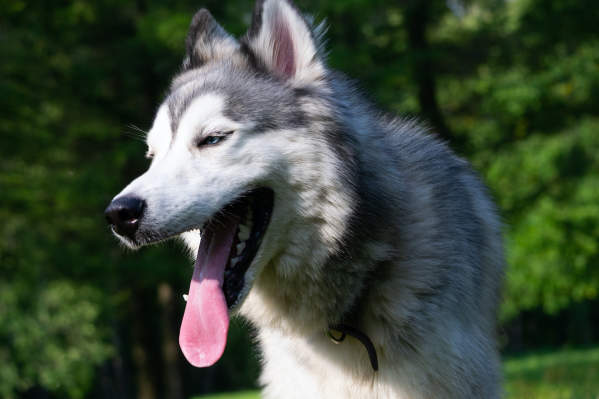The summer can be a great time to play in the sun, and pets love this just as much as their humans do. But as the humidity and temperature continue to rise, how do we know when our dogs have had enough?
The reality is, we can’t help but look at our pets and their thick, beautiful coats and wonder if they're feeling the heat even more than we are. The risk of your dog overheating in the summer (and even in other seasons) can be very high, so we've compiled a list of causes, signs, prevention, and first aid to better help you and your fur baby enjoy the outdoors and stay safe in the warm weather.
Dog overheating causes
Dogs don't have as many natural ways to cool down in hot weather, as their only sweat glands are in their paws. Canine heat stroke is a result of an imbalance between the heat being produced and dissipated. It is dangerous and requires immediate action in order to correct the rapidly rising temperature in dogs, as it can have dangerous side effects and even result in death.
Many cases of canine heat stroke occur with a seasonal change in the weather. Dogs become acclimated to our indoor climate controlled environments. If it's a cold month and there is an increase in the temperature, you may be inclined to have some outdoor playtime with your dog. While this is a great way to spend time with your dog and get in some beautiful sunshine and fresh air, the drastic temperature change can cause your dog to overheat quickly. We often think about overheating in the hot summer sun, but this can occur anytime your dog is playing outside in warmer weather.
Signs your dog is overheating
When it's particularly hot out, it's very important to monitor your dog closely for any combination of the below symptoms and signs your dog is overheating:
Excessive panting
Vomiting
Drooling
Dizziness/collapsing
Diarrhea
Gum discoloration
Increased pulse
Muscle tremors
How to protect your dog from overheating
There are a few things pet parents can do to prevent their dog from overheating.
Hair coat maintenance
Shaving the coat of a dog to allow them to be cooler in warmer weather does not help them, it actually can cause more damage for your dog. A dog’s coat is designed to keep them warm in the winter and cool in the summer.
To help with overheating, regular brushing and combing will loosen the undercoat and allow the coat to have more airflow and therefore help your dog stay cool.
In dogs with light-colored skin and fur, sunscreen should be applied if staying outdoors for an extended period of time. This article includes how to apply and safe sunscreens for dogs.
Panting and temperature regulation
Too cool themselves down, dogs pant, which allows them to move airflow through their mouth and nose. Panting also creates water evaporation across the tongue and creates a cooling effect. When a dog becomes overheated, the panting is greatly increased and their gums can become bright red, indicating that they're unable to regulate their body temperature. If you find your dog excessively panting with red gums, you will need to help your dog cool down with some simple first aid steps (discussed below).
Swimming
Another great way to prevent your dog from overheating and stay exercised this summer is by swimming. Swimming offers a way to cool down while giving your dog a full-body, no impact, workout. Swimming is also beneficial in helping blow out some of that harmful dead undercoat. If your dog needs some assistance with swimming or tires quickly, a doggie life vest will help keep them safe.
Cooling treats
If your dog isn’t a fan of water, that doesn’t mean they have to stay inside. Ice treats can be safely made at home using water, low-sodium bone broth, and fruits or veggies to add some flavor. In addition, some dogs may enjoy munching on ice cubes in a shallow bowl of water.
Cool, fresh water
Cool, fresh water should always be available for your dog, especially when the temperature is rising. Your dog may need to drink more water even after a short walk outside. Taking a water bottle and a travel bowl with you will encourage your dog to drink clean water instead of finding puddles or stagnant water that could contain dangerous bacteria or chemicals.
Breed-specific limitations
Overheating and heat exhaustion is more likely to occur in dogs with short, flat faces like pugs, French bulldogs, and Boston terriers. Dogs with longer faces and noses like the retriever breeds, are able to cool themselves more efficiently since they have a larger nasal canal. However, even large dogs can suffer from overheating and heat exhaustion without the pet parent being cautious and paying attention to any signs of overheating.
Change your play and walk schedule
When temperatures start to rise, especially in the summer months, playtime should be limited and your dog should be given time to take breaks from the sun and heat. For example, if you normally walk your dog around noon in the cooler months for an hour, you should change that walk time to early morning and shorten the length of time in the warmer months. Early morning and late afternoon are safer times to walk and play when it's warm outside.
Don't leave your dog alone in your vehicle
It's not recommended to ever leave your dog unattended in a vehicle. You may be delayed in returning to your vehicle and your dog could be in danger very quickly. If you must leave them unattended, be sure it is no longer than 5 minutes and the temperature outside is above freezing and below 70 degrees.
According to a study in the journal of Pediatrics, a 70 degree temperature outside can turn into 115 degrees inside your vehicle in 30 minutes. This will cause your dog to overheat and be at risk for heat stroke. When it's cold outside, your vehicle can become a refrigerator and cause hypothermia.
Be cautious of ground and pavement temperatures
Another important aspect of the rising temperature outdoors is the ground temperature. Pavement, sidewalks, sand, and dirt can quickly become too hot for your dog’s paws. When stepping outside, check the ground temperature with your hand. Place your palm on the ground for 10 seconds. If you are able to comfortably keep your palm on the ground, it is safe for your dog. If not, your dog may have injuries to their paw pads.
If your dog is used to walking on pavement and sidewalks, their paws should be acclimated to the rougher surfaces and not as susceptible to injury. Softer paw pads, often seen with young puppies or dogs that are not used to walking on rough surfaces, will burn and blister quickly. In addition, dry and cracked pads are also at a higher risk of burns. Doggie boots can be an option, but your dog will need time to get used to them.
Dog overheating first aid and supplies
Most importantly, recognize the signs that your dog might be overheating, especially before it gets too bad. If you think your dog may be overheating or suffering from heat stroke, here are some suggestions to help your dog safely cool down, as well as some items to keep on hand during the warmer months.
Keep a quick-reading digital thermometer available. A dog’s normal temperature ranges from 99.5℉ - 102.5℉. A temperature of 104℉ indicates heat stress, 105℉ indicates heat exhaustion, and 106℉ and over indicates heat stroke.
If your dog is overheating, it's crucial to not cool them down too fast. Avoid cold water baths or drenching them with cold water. The sudden temperature drop can cause serious side effects.
Cool water (not ice cold) can be poured over their head, stomach, armpits, and paws, but placing cool towels over those areas is a safer approach.
Isopropyl alcohol is another method to help cool them down. If your dog is overheating, you can pour some alcohol on a towel and gently press on the paw pads to help begin the cooling process by opening the pores.
A fan should be placed in front of them and allow them to lay on a cool surface.
Continue to take rectal temperatures during the cooling-down process to ensure their temperature is reducing.
If your dog’s temperature is not decreasing or if they have already registered a temperature indicating heat stroke, start cooling them down and seek veterinary care immediately.
If you have questions or concerns about dog overheating, the team at Pawp is here to help 24/7—no appointment necessary.

Reviewed and fact-checked by
Mika, RVT at Pawp
